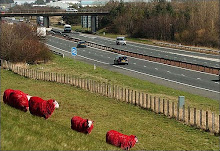Monday 26 April 2010
Glasgow International - so far!
Saturday 17 April 2010
Jannis Kounellis

This work was made at the time of Kounellis’s first involvement with Arte Povera. The carefully dyed but loosely wrapped hanks of uncarded wool epitomise Kounellis’s choice of simple materials at this time. Linked with Arte Povera’s exploration of basic media, they also suggest Kounellis’s attraction to earlier civilisations. Although he had abandoned painting at this stage in his career, he later suggested that the structure of this work had been partly inspired by Jackson Pollock, with the hanging wool teased out to mimic dripped paint. (From the display caption April 2009)
Friday 16 April 2010
Mark making with dye
Intrests so far
- staining- intentional/unintentional/ physical
- growth
- time
- multiple
- markings- mark making- intentional/unintentional
- instability - place/space - relationship
Thursday 15 April 2010
Place-Space
Faith Wilding
Artists Statement My art practice is complex and recombinant, and makes use of whatever media best accommodates the subject matter, content, and purposes of the project at hand. I work in many materials and formats including drawing, painting, printmaking, writing, artist books, performance, and electronic media. My recent mixed media collage works on paper, and my Rorschach-print based "wounds", "embryos" and "fetuses" for example, represent a cherished and long-standing commitment to drawing and printing as a way of exploring psychological and philosophical ideas and cultural phenomena in sensuous visual materials and tactile embodied forms. I think of these works as "recombinants", for they recombine not only traditional media such as watercolor painting and meticulous ink drawing with the much newer methods of collage and montage, but they also speak of the psychic state of the body today - the recombined war body, which has been violently cobbled together from nomadic social, cultural, and political fragments. The recombinant body, which is the subject of much of my work, is an uneasy, monstrous depository of melancholic historical fragments expressed as animal, human, organic, and machine parts. It is a body both beautiful and strange in its monstrous (im)possibilities. I think of my visual work as a kind of "applied theory" based in research about contemporary social and cultural phenomena and ideas. A recent project, Wall of Wounds, is an example of such "applied theory". "Show your wound!" is an imperative which seems to be the motivation fueling TV and radio talk-show entertainment all across America today. Wall of Wounds seeks to comment on this situation using sensuous printed stains and marks on skin-thin tissue paper to restore affect in opposition to the numbing spectacle of pain. At the same time it draws attention to the consumption aspect of the talk-show phenomenon, by inviting the viewer to acquire a personalized wound. I am currently very interested in random and involuntary processes and in the ideas they give me for consciously manipulated and developed images. Embryoworlds is another example of the way in which I combine theory and practice in my work. In this evolving project, I comment on the new "assisted conception" technologies, and on the effects of technoscience on women's lives and bodies globally. This project has everything to do with the languages of science and art which encode our deepest fears, desires, and longings in narratives of evolution, choice, idealization, immortality and perfectibility. For different exhibition venues, I present different aspects of this project which includes computer assisted prints on vellum; small paintings; writing; artist books; sculptural components; collaborative performance and WEB pages. I'm interested in the transformational and pedagogical possibilities of a radical art--an art which uses beauty as a terrorist tactic, rather than an end in itself. Faith Wilding http://faithwilding.refugia.net/ |
Wednesday 14 April 2010
Reinforced Steel

Masonry structures and the mortar holding them together are similar to concrete and also have a limited ability to carry tensile loads. Masonry units like blocks and bricks are made with advantageously placed voids to accommodate rebar, which is then held in place with grout. This combination is known as reinforced masonry.
Highway bridges, parking garages, coastal facilities and other structures have been built using stainless steel rebar sticks.
http://www.rebar-info.com/rebar-info-uses.html
looking at the rebar structure it brings to mind artists such as Sol Le Witt and Tony Cragg.

Sol Le Witt
Tony Cragg

